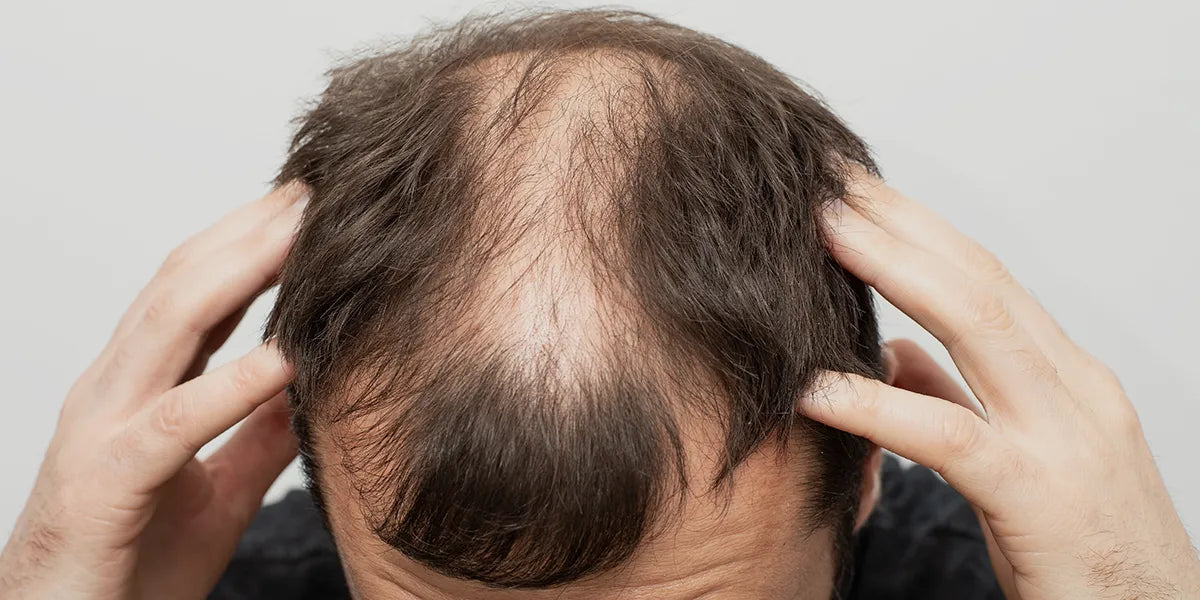Having great hair is an instant confidence boost. But for some, androgenetic alopecia (also known as male pattern baldness) can put a damper on things. It’s a common and progressive hair loss condition that can lead to drastic changes in the appearance of hair if left untreated. In this article, we break down exactly what androgenetic alopecia is and the latest theories about what causes it.
What is androgenetic alopecia?
Androgenetic alopecia (AGA) is a form of hereditary and hormonal hair loss that results in balding along the hairline, temples and at the top of the head. It's a progressive condition that can start anytime after puberty and affects approximately 50% of men by the age of 50, with a higher incidence among Caucasian men (Ho et al., 2020).
The specific hormone implicated in AGA is dihydrotestosterone (DHT), which is related to testosterone. Together, testosterone and DHT belong to a class of hormones called androgens.
While DHT is present throughout the body and serves key functions in biological males, increased sensitivity of hair follicles to DHT can trigger the development of AGA in genetically predisposed individuals (Rossi et al., 2016). These genetic differences cause scalp tissues to respond to, produce and metabolize (break down) DHT differently.
Treatments that lower DHT can help address hair loss before it's too late. Talk to a doctor today.


You don't have to accept hair loss. Get ahead of it.
What causes androgenetic alopecia?
A primary cause of male pattern hair loss is increased activity of DHT. When DHT attaches to its hormone receptor on hair follicles in the scalp, a process called follicular miniaturization is triggered.
Follicular miniaturization and androgenetic alopecia
Follicular miniaturization is a gradual process that involves changes to the timing of the hair growth cycle and shrinking of the hair follicle. The causes of miniaturization are still being studied, but one theory is that the attachment of DHT triggers premature cell death (Cranwell & Sinclair, 2016). When the dermal papilla cells of the hair follicle are affected, the follicle may not regenerate properly.
Miniaturized hairs have a distinctive appearance. They are referred to as vellus hairs and are often shorter, finer and lighter in colour. In advanced AGA, hairs may become too fragile or short to break the surface of the scalp, leading to the appearance of bald spots (Rathnayake & Sinclair, 2010).
Miniaturization can also progress to the point where hairs lose contact with the skin structures that hold them in place. When this occurs, hairs fall out leaving behind empty follicles (Cranwell & Sinclair, 2016). At this stage, follicles are said to be dormant and hair loss is very difficult, if not impossible to reverse. This is one of the reasons why timely and consistent treatment of AGA is so critical.
Microinflammation and androgenetic alopecia
In addition to hormones, researchers have also looked at other factors that may contribute to male pattern baldness. One proposed mechanism is microinflammation, or localized, long-term inflammation of the hair follicle.
Inflammation is one aspect of the body’s overall immune response and can be triggered by environmental, biological or physical factors such as:
- Toxins produced by the overgrowth of bacteria naturally present on the scalp
- Excessive sun exposure, which causes cells to produce metabolic byproducts that can cause damage to building blocks of cells, like fats, proteins and DNA (Rossi et al., 2016).
These agents prompt the body to release molecules that coordinate an inflammatory response. Some of these molecules have been associated with premature cell death (apoptosis), leading some scientists to speculate that inflammation could play a role in follicular miniaturization.
Androgenetic alopecia: Takeaway
AGA affects millions of people worldwide. It is a treatable condition and individuals usually respond well to therapy, provided hair loss is identified and treated early.
Being proactive about AGA is not just a matter of saving your hair. At XYON, we understand the potential impact of hair loss on all aspects of your life. If you know that you have a family history of balding or have started to notice thinning hair or unusual shedding, consider talking to a doctor to determine if treatment may be necessary.
Start a consultation today with an independent, board-certified dermatologist through the XYON Health platform if you think you might be experiencing hair loss.




